Relief from Admissions
Templates and Forms
During discovery, each party may serve one or more sets of requests for admissions, asking the opposing side to admit that one or more facts are true or one or more documents are genuine. If a party admits a fact, or admits that a document is genuine, that fact, or the genuineness of the document in question, does not need to be proven at trial.
Occasionally, a party may inadvertently or mistakenly admit a fact that is not true, or may fail to respond to a request for admissions altogether, resulting in a court order deeming each of the facts listed in the request for admissions to be true, and each document listed in the request to be deemed genuine.
This Guide provides step-by-step instructions for asking to be relieved from these admissions, including a sample motion and a template that can be downloaded and modified to fit the facts and circumstances of your case.
Related Step-by-Step Guides
Related Videos
Grounds for Relief
California Code of Civil Procedure (CCP) § 2033.300(b) allows a court to permit the withdrawal or amendment of admissions only if the court “determines that the admission was the result of mistake, inadvertence, or excusable neglect, and that the party who obtained the admission will not be substantially prejudiced in maintaining that party’s action or defense on the merits.”
Mistake, Inadvertence, or Excusable Neglect:
The party asking to be relieved from admissions must present sufficient evidence for the court to find that the admissions or failure to respond to the request for admissions was the result of a mistake, inadvertence, or excusable neglect. The act or omission that led to the admission must be one that a reasonably prudent person under the circumstances would make. Forgetting about the admissions, being too busy to properly respond, or being unable to afford an attorney are not sufficient grounds for relief. Some examples of reasons that might be excusable include:
- An unanticipated illness or injury that disabled the party, preventing him or her from responding;
- Reasonably, but mistakenly, believing that your former attorney had responded, based upon his or her representations;
- Having never received the request for admissions and subsequent motion to deem the admissions true, through no fault of your own;
- Misunderstanding a particularly complicated request, and incorrectly responding “admit” based upon this misunderstanding;
- Admitting or denying a fact based upon the information available at the time, only to determine through later-discovered evidence that your previous response was incorrect;
- Making a typographical error in the numbering of your responses such that your admissions do not correctly correspond to the requests, resulting in false statements being admitted, and true statements being denied.
Party Obtaining Admission Not Substantially Prejudiced in Maintaining Action:
After determining that an admission is the result of a mistake, inadvertence, or excusable neglect, the court must then consider whether the party that obtained the admission will be prejudiced if your motion to relieve the admission is granted. Some of the factors the court might find important in determining whether the other party will be prejudiced include, but are not limited, to:
- The promptness in which relief from admissions is granted;
- The nature of the facts that were admitted or deemed admitted;
- The reliance of the requesting party on the admission in conducting or not conducting further discovery.
In order to minimize any prejudice to the propounding or requesting party, the court may extend or reopen discovery, allow additional discovery, or make other orders to reduce any harm caused in granting your motion to be relieved from admissions.
As the party requesting to be relieved from the admissions, it is your burden to prove to the court both that the admission was the result of a mistake, inadvertence, or excusable neglect, and that the propounding party will not be prejudiced by the granting of your motion for relief from admissions.
Writing and Preparing the Motion
There is no Judicial Council form for this procedure. Instead, the relevant document must be typed on 28-line pleading paper. A customizable template may be downloaded from this link:
A filled-out sample is shown at the end of this guide.
Preparing a motion is not a quick or easy task. This guide attempts to break the process into manageable steps to help you file your motion successfully. For more details about writing and filing motions, see our guide Motions in Civil Cases.
Step-by-Step Instructions
1
Schedule and Reserve a Hearing Date
This information is for Sacramento. If your case is in a different county, do not follow these instructions. Instead, call the clerk or visit the court website in your county to find the correct information.
Determine the department and time of the motion
This is considered a “Law and Motion” matter. In Sacramento, Law and Motion hearings are heard in Department 53 at 1:30 p.m. or Department 54 at 9:00 a.m., Tuesday-Thursday. To determine which department your hearing will be in, check your case number. Odd numbered cases are heard in Dept. 53, even numbered cases in Dept. 54. (There are occasional exceptions, so if you’ve been assigned to one or the other in the past, use that one.)
Reserve the date for the hearing
In Sacramento’s Departments 53 and 54, you must reserve a court date through the court’s online reservation system.
To use the online system, go to the Sacramento Superior Court’s Public Portal and choose “Reservation System (CRS).” You must have a free account on the system to use it.
Before you log on or call, figure out if there are any days you will not be available during the next couple of months. For instance, you don’t want to pick a date when you know you will be out of town.
You must choose a date far enough in the future that you can both file and serve your motion on time. Scheduling it four weeks in advance generally gives a comfortable margin for most types of motions. Usually, the first available date will be further away than that.
Determine the legal deadline to file the motion in court
Tip: File the motion as soon as possible. Your reservation is not final until the motion has been filed and any fees paid.
The last legal day to file with the court is at least sixteen court (business) days prior to the motion date (CCP § 1005). “Court days” are Monday through Friday, excluding court holidays. To determine whether a particular filing date will meet this deadline, start counting backwards on the day before your hearing until you reach the sixteenth court day. (CCP § 12c)
For example, suppose your reservation is for Monday, June 18. You would start counting backward using the previous court day, Friday, June 15, as day one, as shown in the calendar below. Skip weekends and court holidays (there is one court holiday in this example, which is Memorial Day, May 28). The sixteenth court day before the hearing would be May 24, which would be the last day that the motion could be filed.
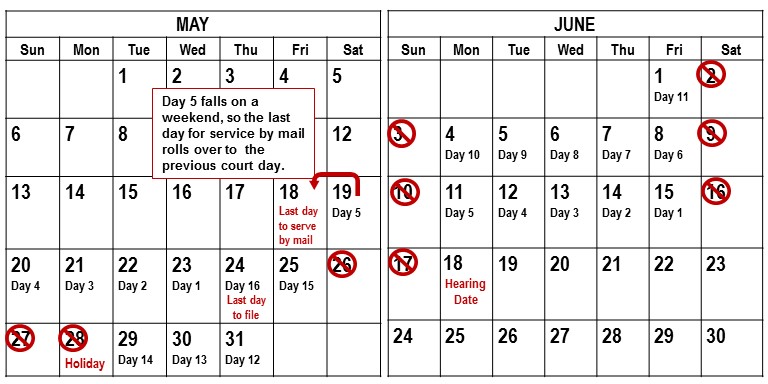
Holiday Heads-Up: The California courts are closed on several holidays that you may not expect, including Lincoln’s Birthday (Feb. 12); Cesar Chavez Day (March 31); Juneteenth (June 19); and Native American Day (third Friday in September).
Make a note on your calendar to file the motion by this date. Do not miss this deadline. The court will cancel the hearing and you will have to start over.
Determine the legal deadline to serve the motion on the other parties or their attorneys
You must have all other attorneys (or self-represented parties) served with a copy of the motion, then have the server fill out a Proof of Service which you file along with the motion. This means that someone over the age of 18 who is not a party in the case must either mail or personally deliver a copy of the motion and related documents to them. There is a strict deadline to do this (earlier is always fine).
Personal service: 16 court days before the hearing, the same as the minimum filing deadline. The server can fill out Proof of Personal Service—Civil (POS-020).
Service by mail: 16 court days before hearing PLUS five calendar days before the hearing (more if the mailing address is outside California). (CCP § 1005). The server can fill out Proof of Service by First-Class Mail—Civil.
“Calendar days” include weekends and holidays, but if the final day lands on a weekend or holiday, it is pushed back to the previous court day.
Make a note on your calendar to have the motion served by mail before the deadline. If you miss the mail deadline, you can still have the motion served by personal service up until 16 court days before the hearing. If you miss that deadline, you will have to cancel your court date and start over.
2
Prepare the Motion
There is no pre-printed form for this motion. You will need to customize a motion on “pleading paper.” Instructions and a sample motion are at the end of this guide.
Parts of a Motion
A request to deem an opposing party’s admissions true is made through a motion. A motion is a request to the judge to issue an order of some sort.
A written motion consists of four parts (the Notice of Motion and Motion are combined):
- Notice of Motion and Motion;
- Points and Authorities; and
- Declaration
The Notice of Motion lets the opposing party know when and where the motion is scheduled to be heard, while the Motion lets the court and the opposing party know what is being requested. The Points and Authorities explains to the court and the opposing party the legal basis of the motion, while the Declaration provides evidence, sworn under penalty of perjury, supporting the motion.
The parts can be filed as separate documents or combined into one document, as in our template motion.
Modify the Template Motion
There is no Judicial Council form for this procedure. Instead, the relevant documents must be typed on 28-line pleading paper. A customizable template may be downloaded from this link:
More information about how to customize the template is included on the sample at the end of this guide.
Include Proposed Responses in your Declaration: All Motions to be Relieved from Deemed Admissions must include a copy of the Proposed Responses to Request for Admissions. Because you have missed the original deadline, you are no longer allowed to raise any objections. For information about how to create your responses, see our guide Responding to Requests for Admission.
3
Copy Your Documents and Serve the Other Party or Parties
You must serve one copy on each other party in the case, and have the server sign the Proof of Service form.
Make the required number of copies to serve on the parties, plus two copies to file along with the original. You can make an extra copy for yourself if you like, for a total of three copies to file — the clerk will stamp your copy and hand or mail it back to you.
Choose someone to serve your documents on the other party or parties. Your motion must be served by a person over the age of 18 who is not a party to the case. Usually motions are served by mail. They can be served by personal delivery if the mail service deadline has passed (see discussion of deadlines, above).
Your server must complete a proof of service form, either Proof of Service by First Class Mail (POS-030) or Proof of Personal Service (POS-020).
Fill out the appropriate proof of service form, but do not have the server sign it yet. Make a copy of the unsigned proof of service before proceeding and staple after the last page of the copy or copies you will have the server serve.
The server must then serve the other party’s attorney (or the other party, if they do not have an attorney), then sign the Proof of Service form and return it to you. For more information on these Proofs of Service, see our guides for Serving Documents by Mail and Service by Personal Delivery.
4
Copy and Assemble Your Documents for Court
You must turn in the original and two copies to the court. Sacramento County has specific requirements for how you compile and submit motion documents. In other counties, check with the local civil department to find out their requirements.
Now that you have the signed Proof of Service, make copies of it to file in court along with the Motion.
- Leave the original Motion and Proof of Service unstapled.
- Insert numbered tabs for the exhibits in one of the copies of the Motion.
- Staple the copies of the Motion.
Place the original and copies of each document in a stack. In this case, you may only have two stacks — the Motion and the Proof of Service:
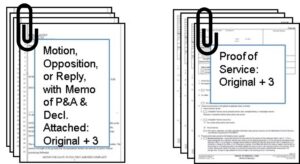
5
File Your Motion in the Law and Motion Department
As long as your filing is received by the deadline (16 court days before the hearing), you can file at the counter, by dropbox, or by mail. But note that it must be received by the deadline. Postmarked does not count.
File the original (with original signed proof of service) and two copies (with copied proof of service) of your motion at the Law & Motion Civil Filing Window in Room 212 on the second floor of the Hall of Justice building, located at 813 6th Street in downtown Sacramento. If you want an extra copy for yourself, file original and three copies and request a “conformed” (stamped) copy back.
Filing Fee: There is a $60 fee to file a motion.
Fee Waiver: If you are receiving government benefits such as Medi-Cal or are otherwise qualified because of low income, you may qualify for a fee waiver. If you applied for one when you filed the case, there will be no fee. If you have not yet applied for a fee waiver, turn the fee waiver request forms in with the motion instead of a fee payment. For more information, see our Step-by-Step guide on Fee Waivers.
6
Opposition to Motion and Your Optional Reply
If the other party serves an Opposition without also serving proposed responses, you may choose to file a Reply.
If any opposing counsel or self-represented party opposes your motion, he or she may serve and file an opposition at least nine court days prior to your motion. No fee is required to file an opposition. The opposition contains a memorandum of points and authorities and usually a declaration, but does not need the notice of motion or motion. Be sure to check your mail, and read any documents you receive carefully.
If the other attorney or party opposes your motion, you may choose to serve and file a reply to the opposition at least five court days prior to the motion. CCP § 1005. It must be served by overnight mail to reach the opposing party no more than one day after it is filed.
The reply is optional and is usually used to address new issues your opponent raised in the opposition. No fee is required to file a reply. See our guide on Writing, Scheduling, and Opposing Motions for more information.
8
Review the Tentative Ruling and Notify Court and Opponent if You Wish to Appear
Before the hearing, the judge reads the motion and opposition and decides how they are going to decide. They post the decision on the court’s website for the parties to read by 2 p.m. the court day before the hearing. The parties can then decide whether it is worth their time to request oral argument on the day of the hearing.
Pursuant to Local Rule 1.06, the judge in Dept. 53 or 54 reads the papers ahead of time and posts a tentative ruling by 2:00 p.m. the court day before the hearing. You then have two hours to request oral argument, if you choose to do so. Unless one party requests oral argument, the tentative ruling will automatically become the actual ruling.
You may read the tentative ruling online, or may call Department 53 (916-874-7858) or Department 54 (916-874-7848) to hear it. For more information, see the Sacramento County Superior Court’s Tentative Ruling Information.
Closely review the tentative ruling. As the party making the motion, you are looking for your motion to be “GRANTED.” The motion may also be “DENIED” or “GRANTED IN PART” and “DENIED IN PART.” Occasionally the judge will order the parties to appear. Be sure to read the tentative ruling very carefully to make sure you understand it.
If You Want to Talk to the Judge
If you are not happy with the tentative ruling, and wish to present oral argument in front of the judge, you must call all opposing counsel and/or self-represented parties, and also call the Law and Motion Oral Argument Request Line at (916) 874-2615 before 4:00 p.m. that same day. State that you are requesting oral argument on the motion. If you do not do this, your hearing will be canceled. Be aware that the judges very rarely change their tentative rulings.
If you are happy with the tentative ruling, you do not need to do anything. You won’t have to go to court unless the tentative ruling orders you to appear, or the other side calls you and the court before 4:00 p.m. that same day to request oral argument. If that happens, you should go to the court hearing and be prepared to argue your case.
If neither party calls the court and opposing party to request oral argument, the court will simply cancel the hearing and finalize the tentative ruling.
9
Attend the Hearing, if Necessary
If neither party calls the court and opposing party to request oral argument, the hearing will be cancelled and the tentative ruling will become final.
If you or the other party request oral argument, you can attend in person or remotely by video or phone call using the Zoom app. The tentative ruling will explain how to connect if you choose to use Zoom.
If you or the other party notify each other and the court that they plan to attend the hearing, you have the option of attending in person or by video or telephone using Zoom.
In person: Go to 813 Sixth St., in downtown Sacramento, in plenty of time to arrive before your hearing starts. Leave early if you will need to find parking, since the courthouse does not have a parking lot. The nearest pay lot is at the corner of 7th and G, at least a 5-minute walk away. When you arrive at the Hall of Justice, go to the second floor and enter the courtroom (Dept. 53/54). Check in with the staffer seated by the door.
Using Zoom: instructions are listed on your tentative ruling. Be sure to log on a bit early.
What to expect: Since you are the moving party, the judge will ask you to explain your request first, then ask the opposing party to respond. The judge will usually decide immediately whether whether to grant the motion or not, but may “take it under consideration” and mail out their ruling a few days later.
For Help
SH@LL (Self-Help at the Law Library) (formerly Civil Self Help Center)
609 9th Street, Sacramento CA 95814
(916) 476-2731 (Appointment Request Line)
Services Provided: SH@LL provides general information and basic assistance to self-represented litigants on a variety of civil legal issues, including name changes. All assistance is provided by telephone. Visit “What we can help with” for a list of qualifying cases.
Eligibility: Must be a Sacramento County resident or have a qualifying case in the Sacramento County Superior Court.
For More Information
Introduction to Discovery – Part 3: Response to Request for Admissions
This video was created by Sacramento County Public Law Library’s Civil Self Help Center to assist self-represented litigants in responding to requests for admissions, and may be helpful to prepare your proposed responses.
California Civil Discovery Practice KFC 1020 .C35
Electronic Access: On the Law Library computers, using OnLaw.
California Practice Guide: Civil Procedure Before Trial KFC 995 .W45
California Forms of Pleading and Practice KFC 1010 .A65 C3 (Ready Reference)
Electronic Access: On the Law Library computers, using Lexis Advance.
California Civil Practice: Procedure KFC 995 .A65 B3
California Points and Authorities KFC 1010 .B4 (Ready Reference)
Electronic Access: On the Law Library computers, using Lexis Advance.
Sample
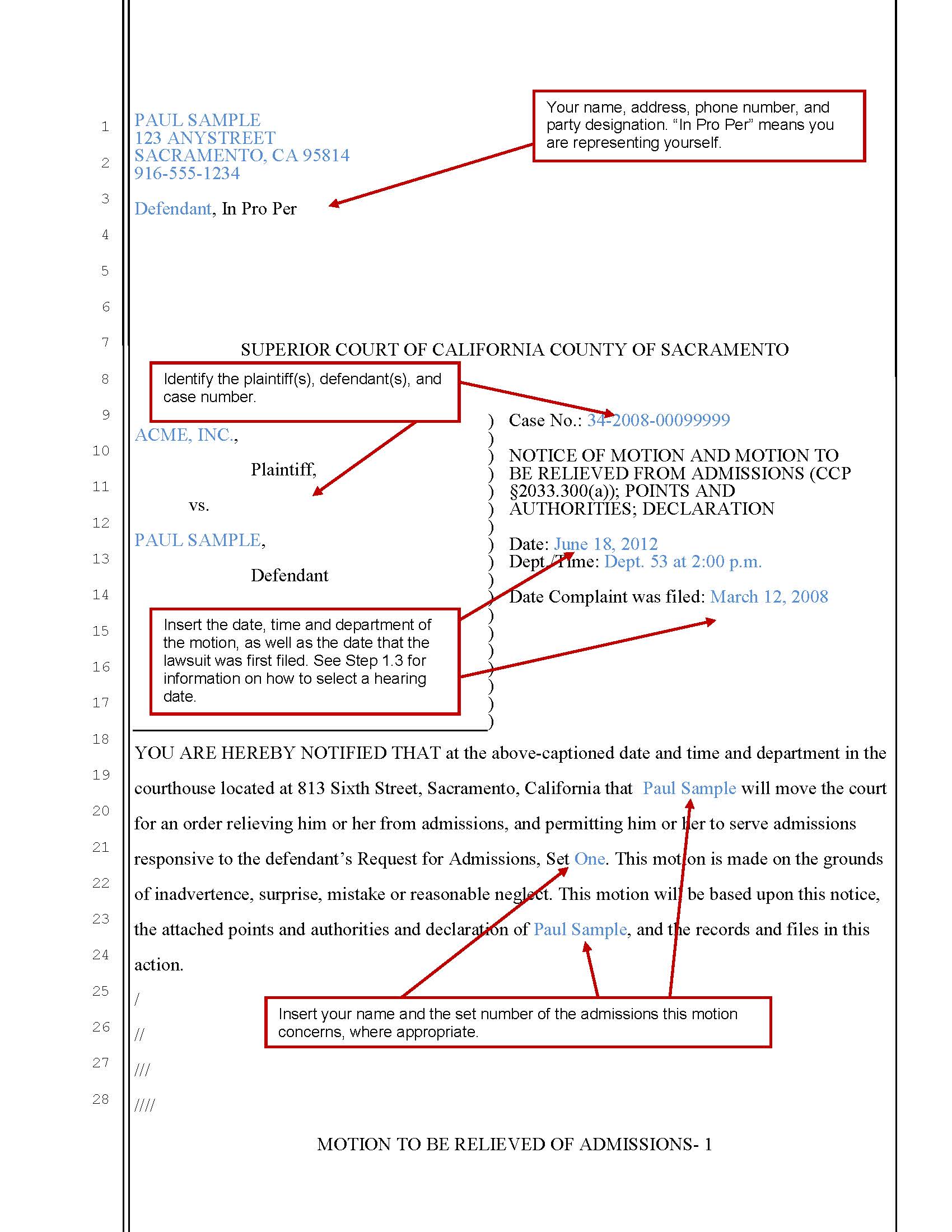
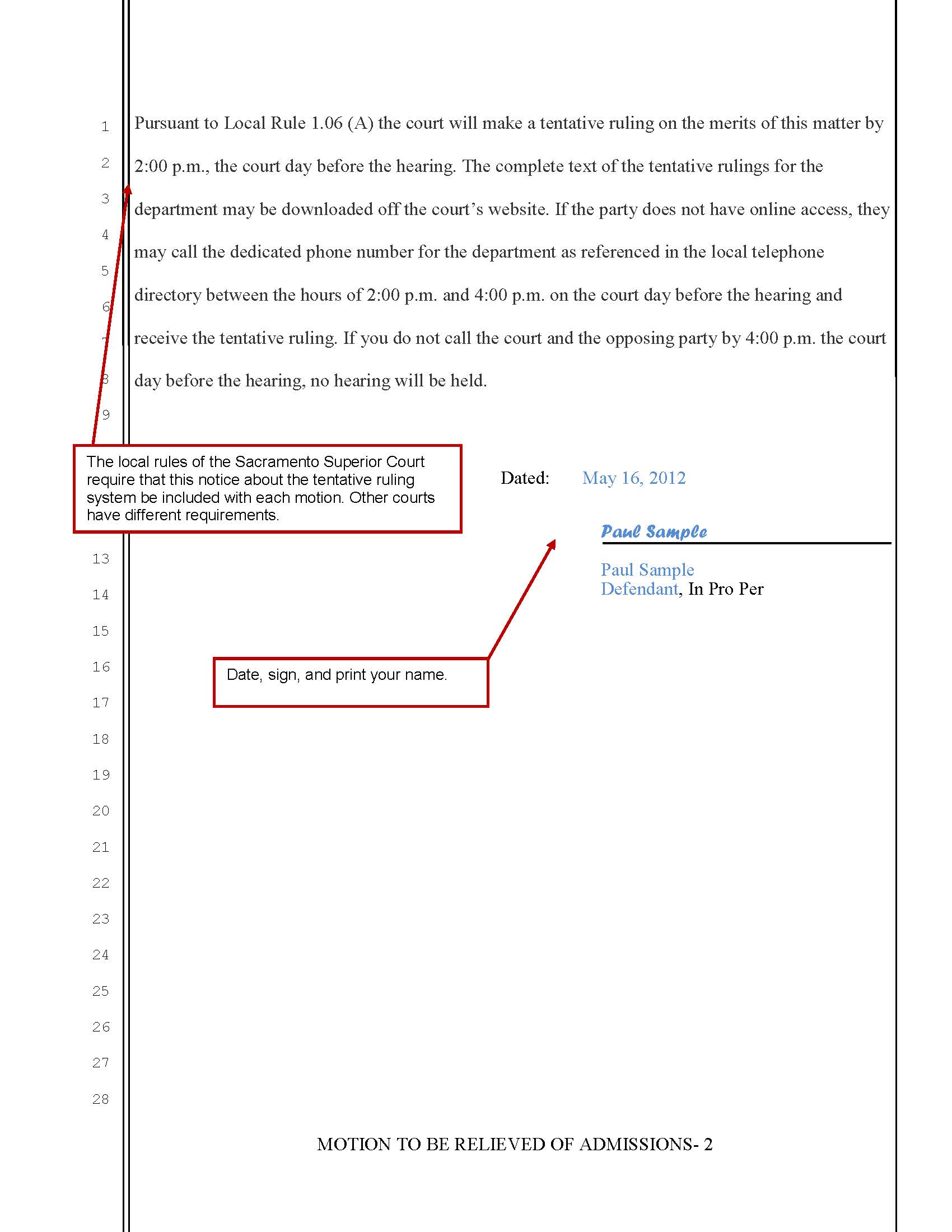
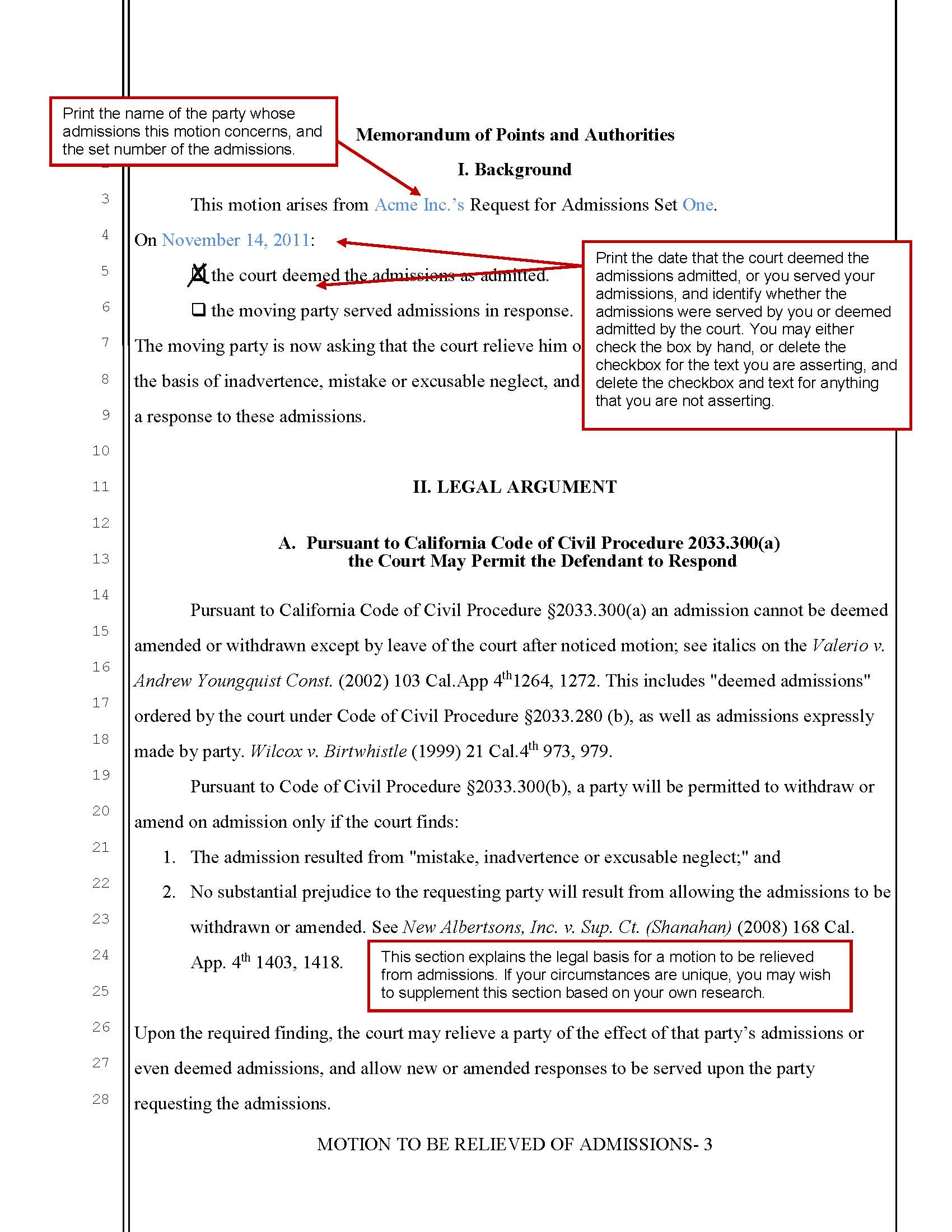
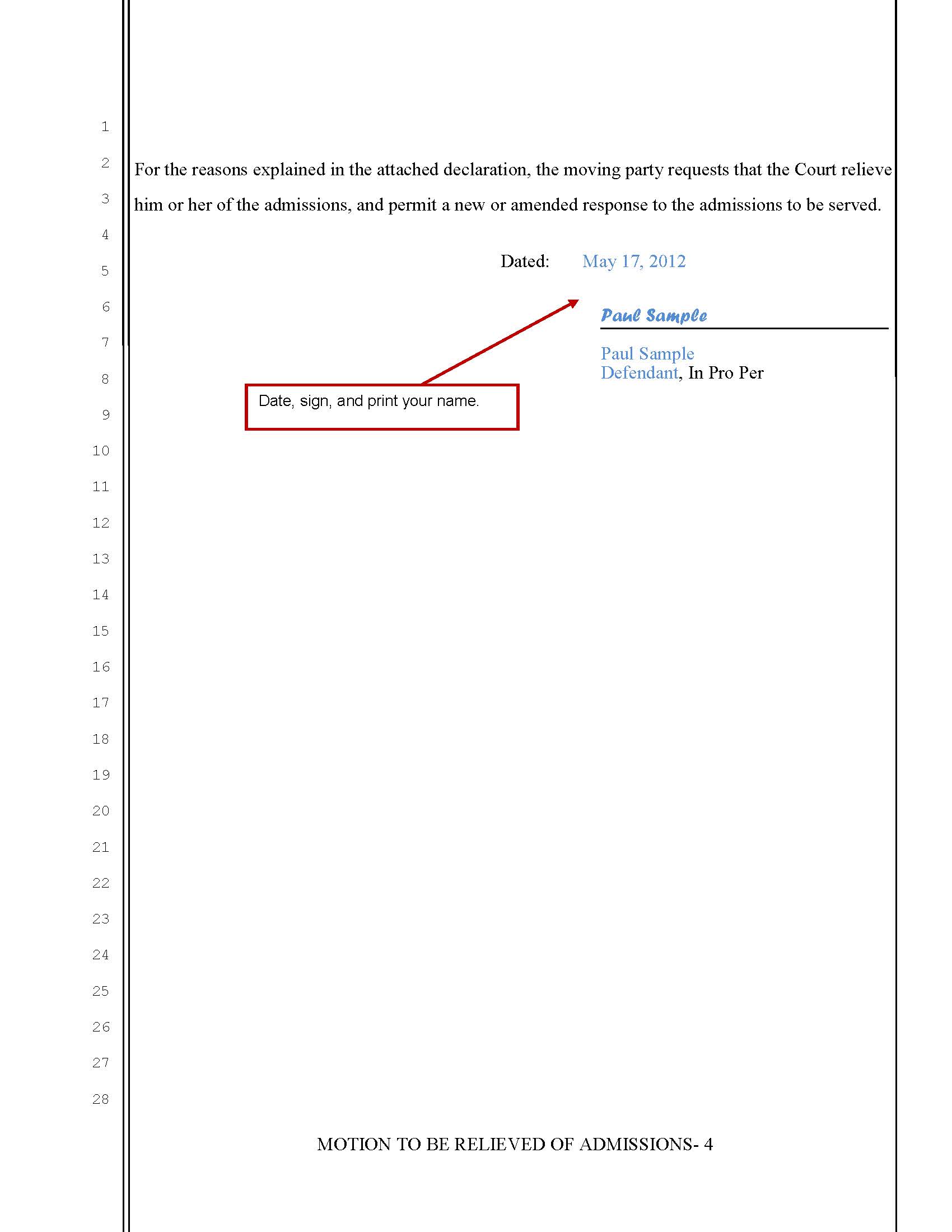
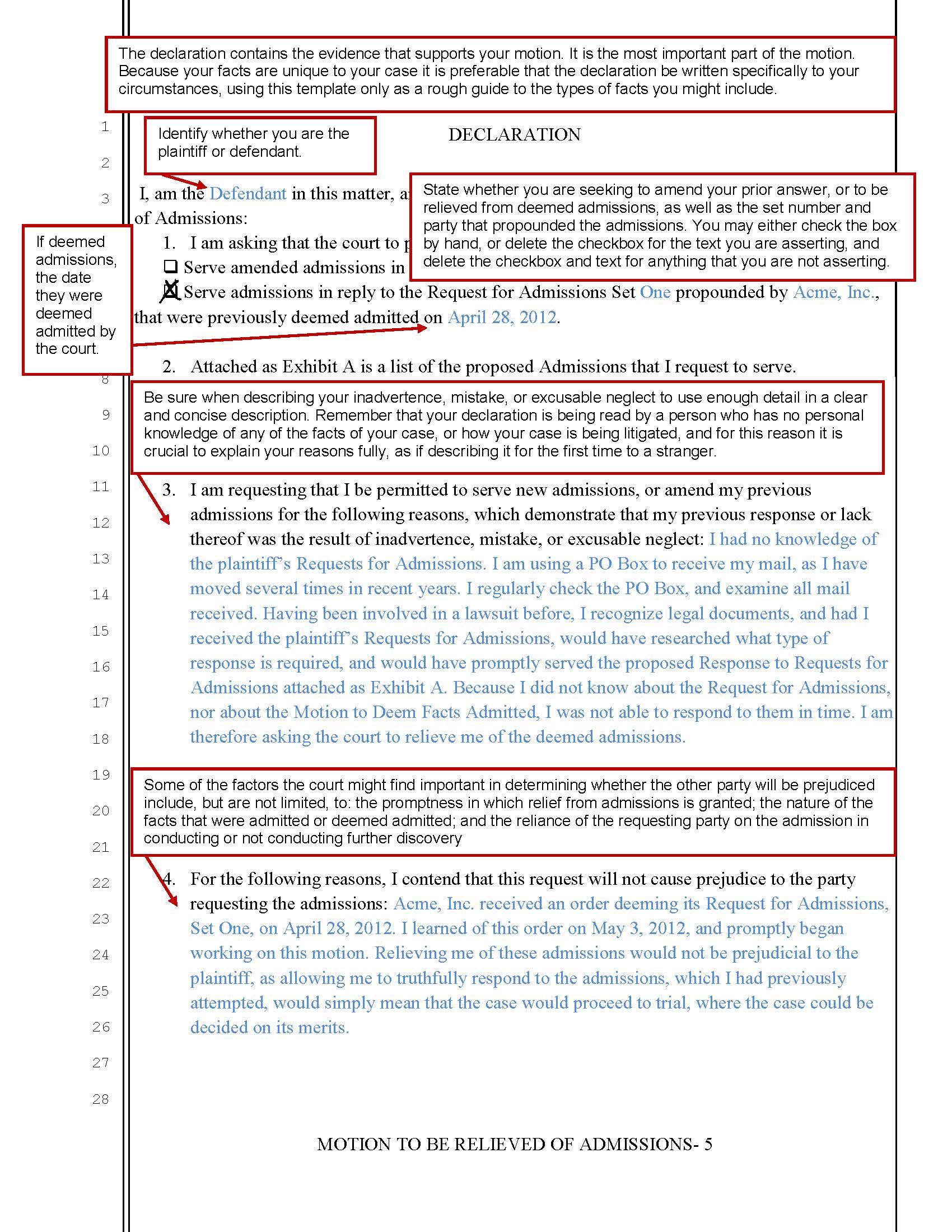
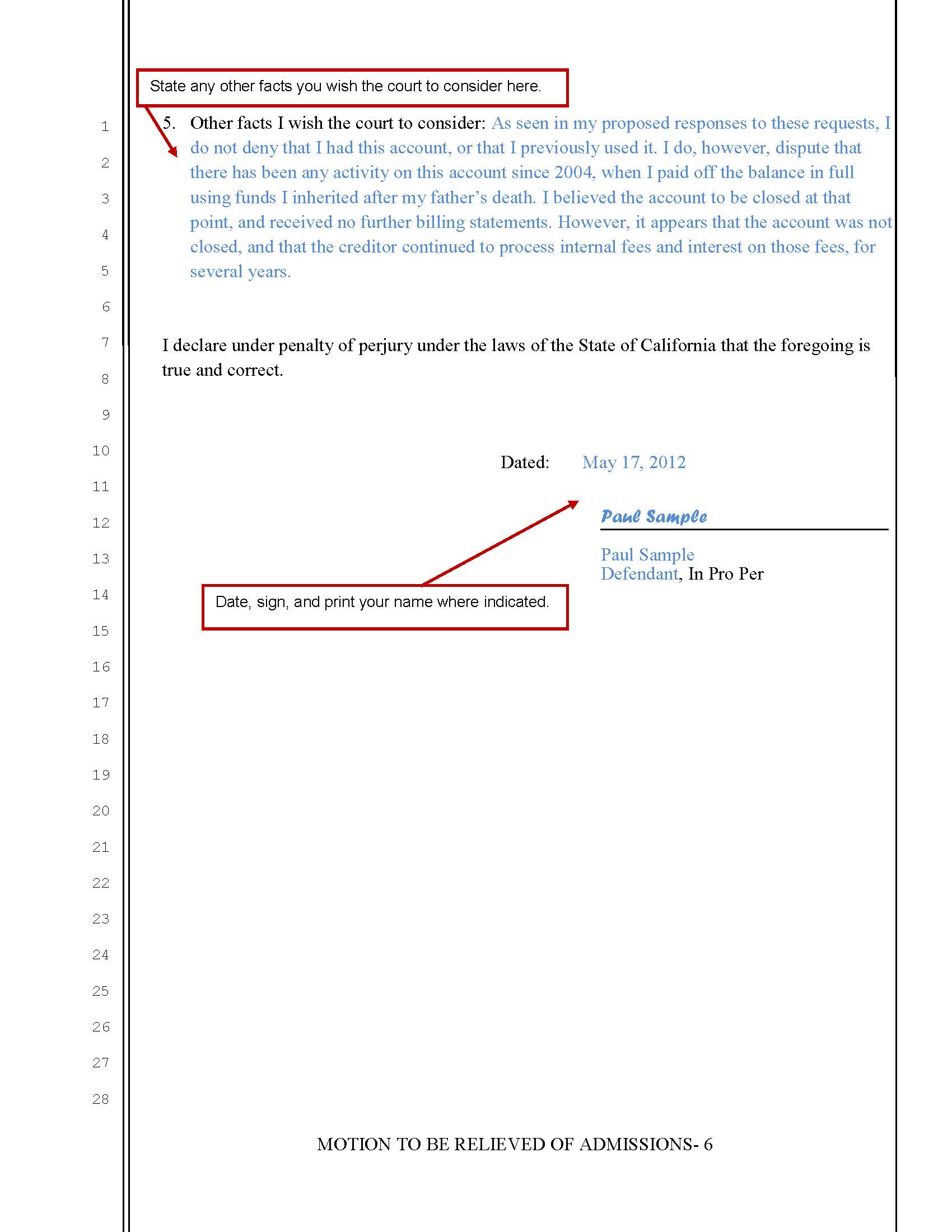
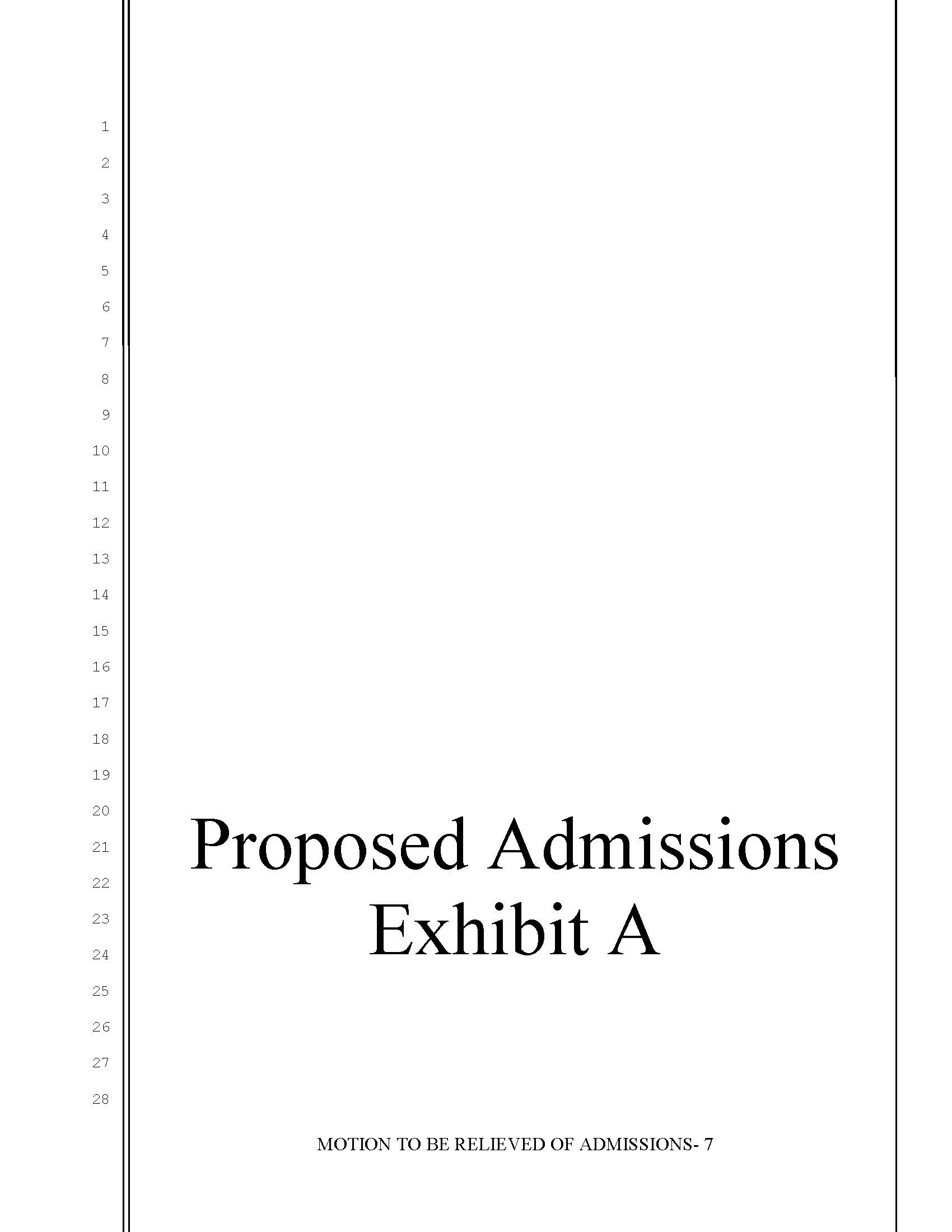
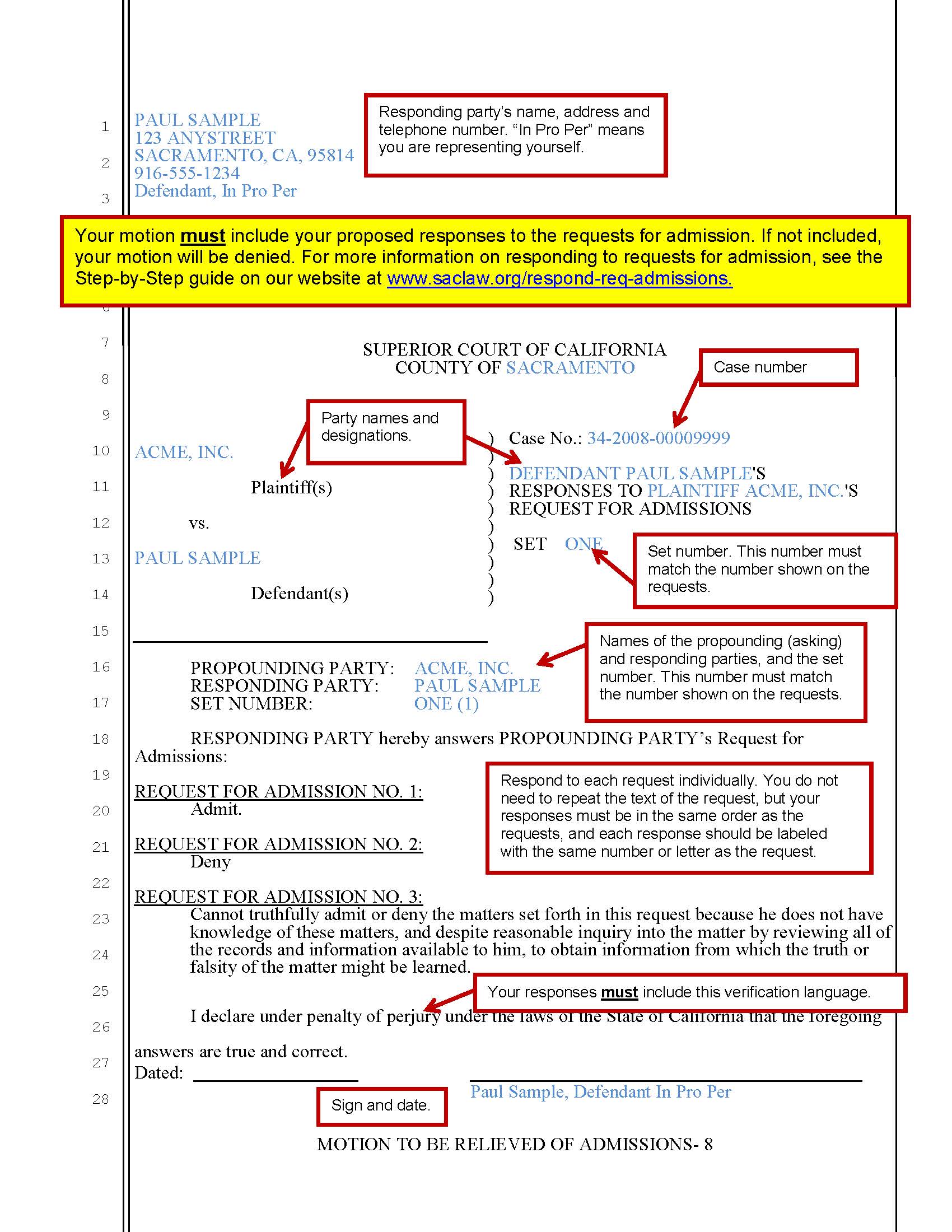
This material is intended as general information only. Your case may have factors requiring different procedures or forms. The information and instructions are provided for use in the Sacramento County Superior Court. Please keep in mind that each court may have different requirements. If you need further assistance consult a lawyer.




